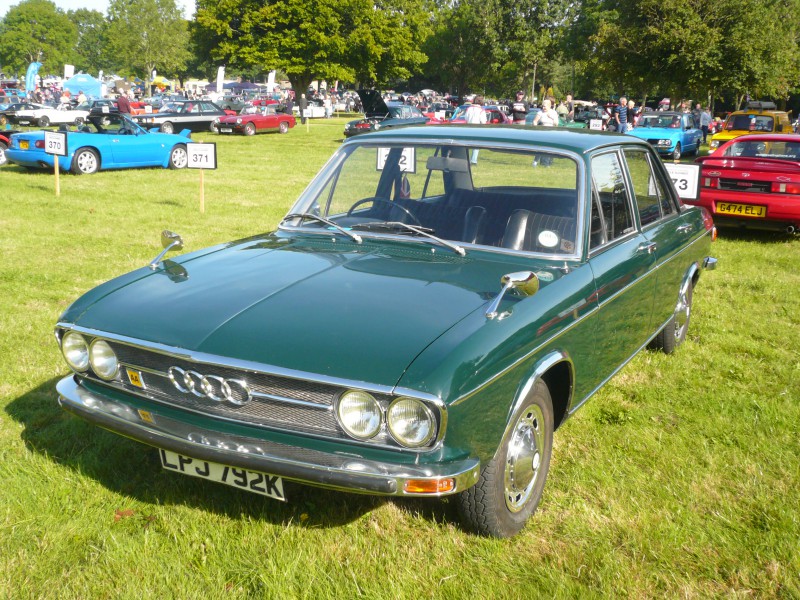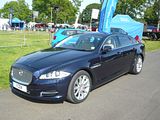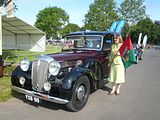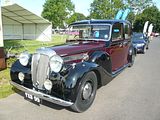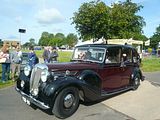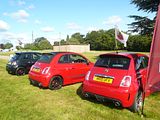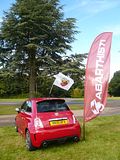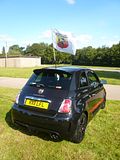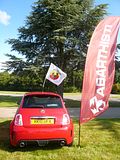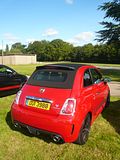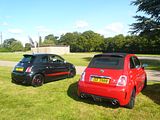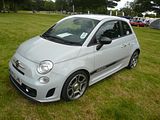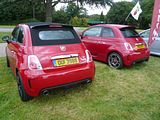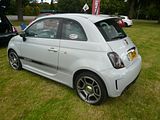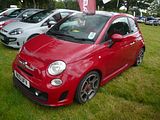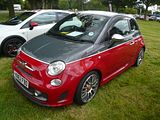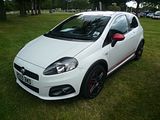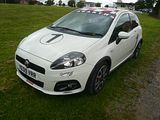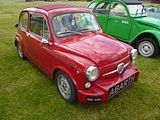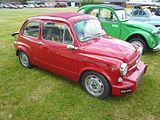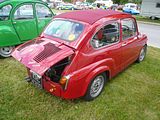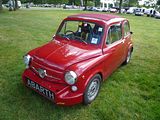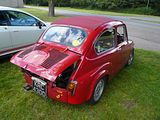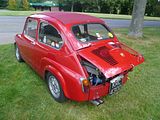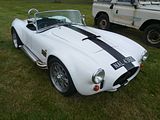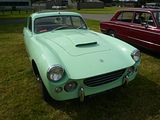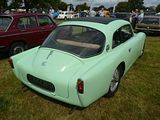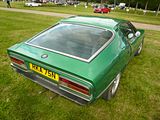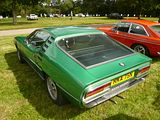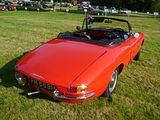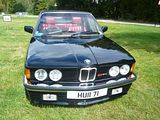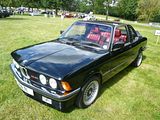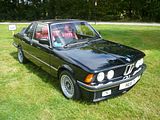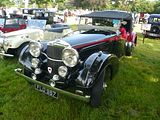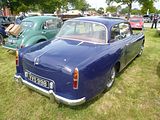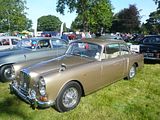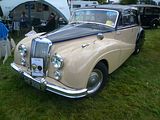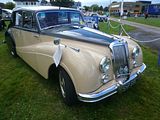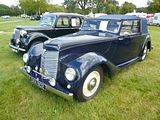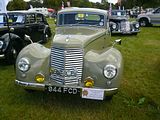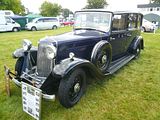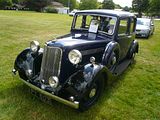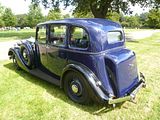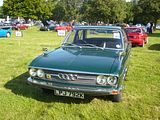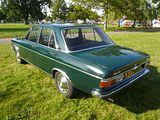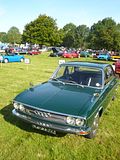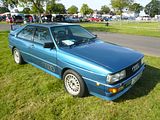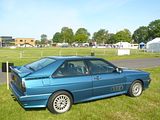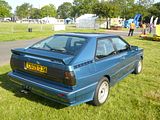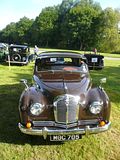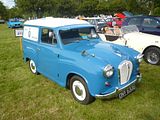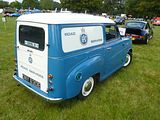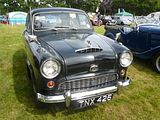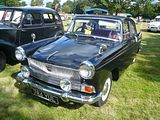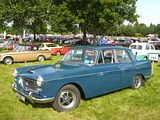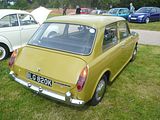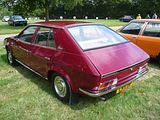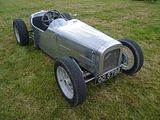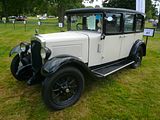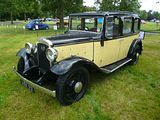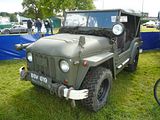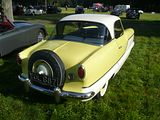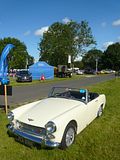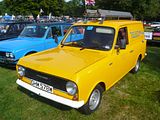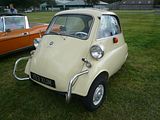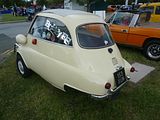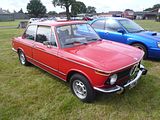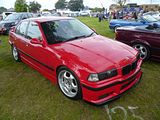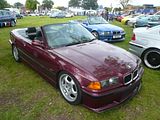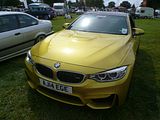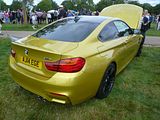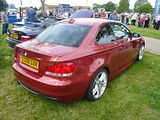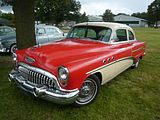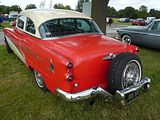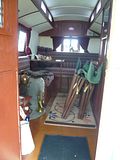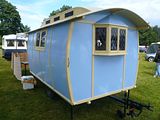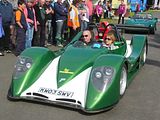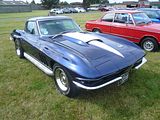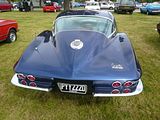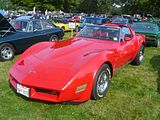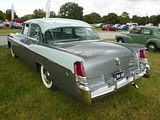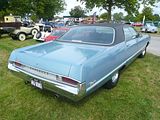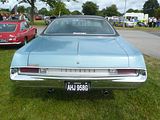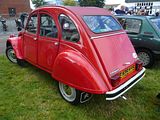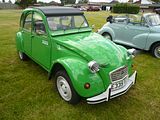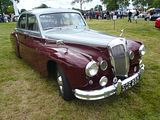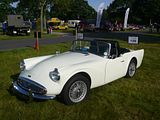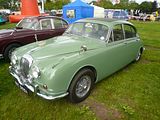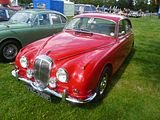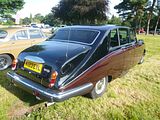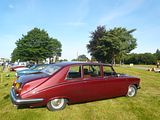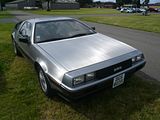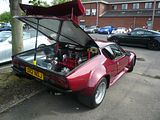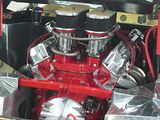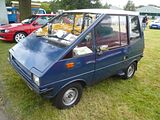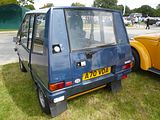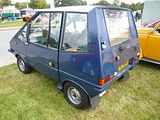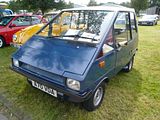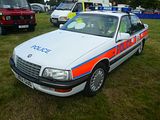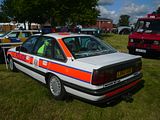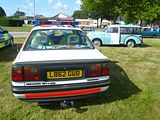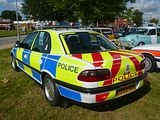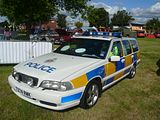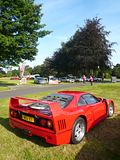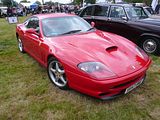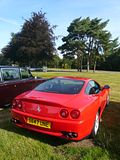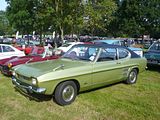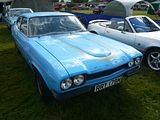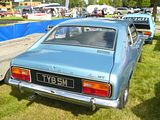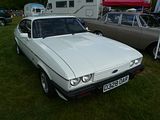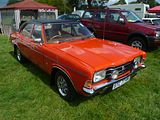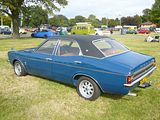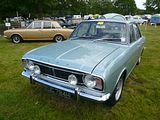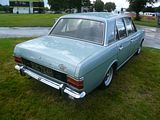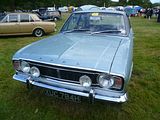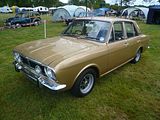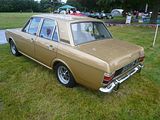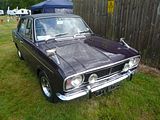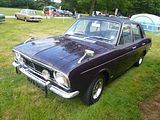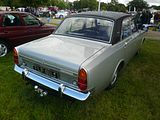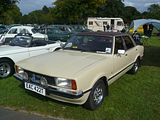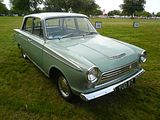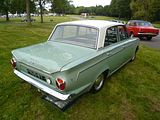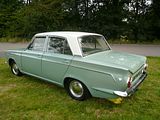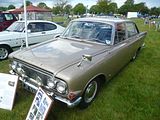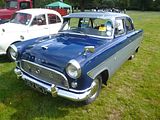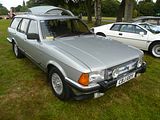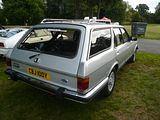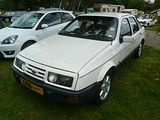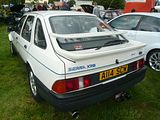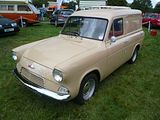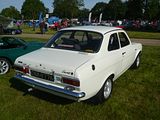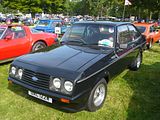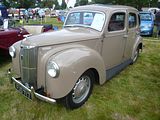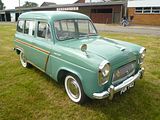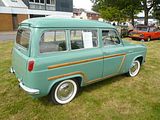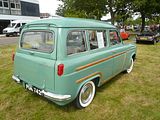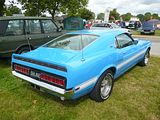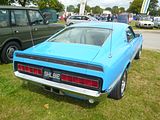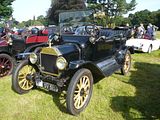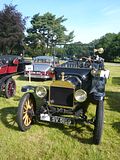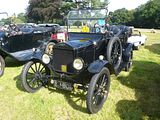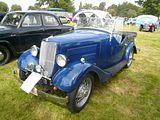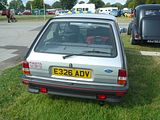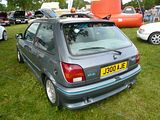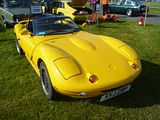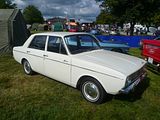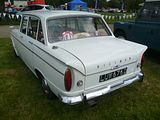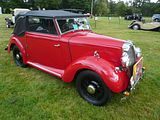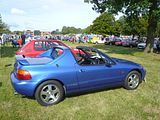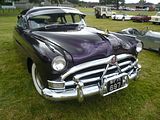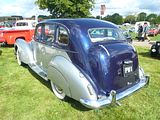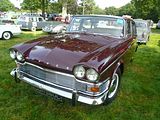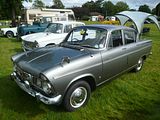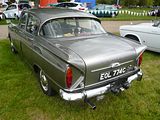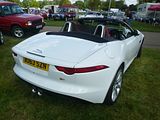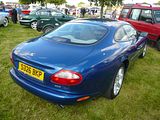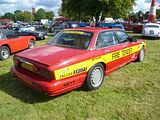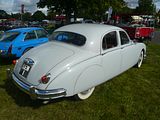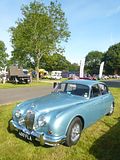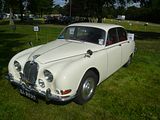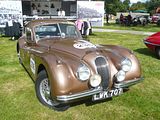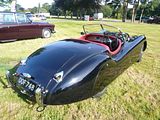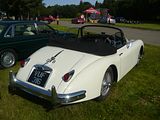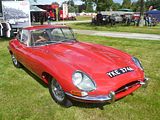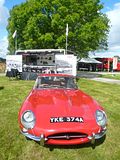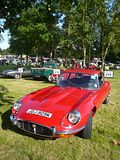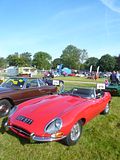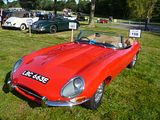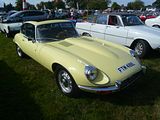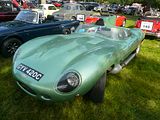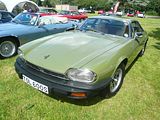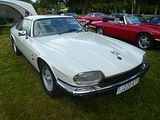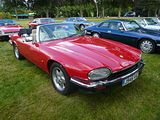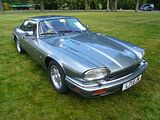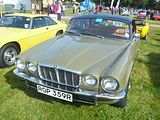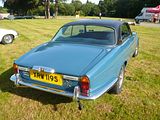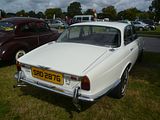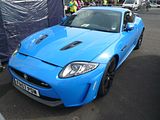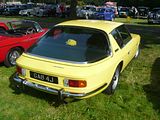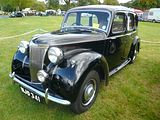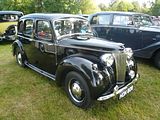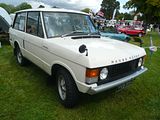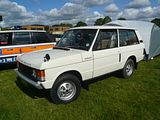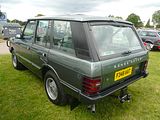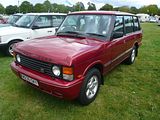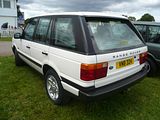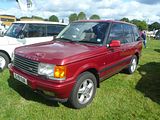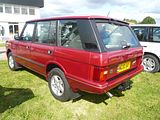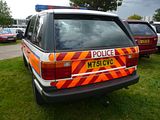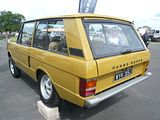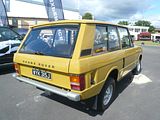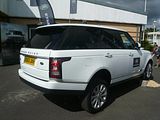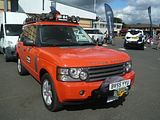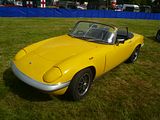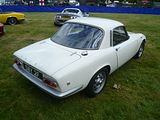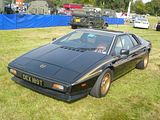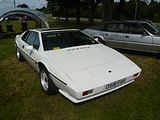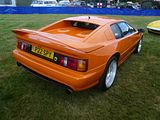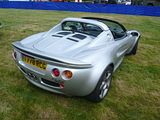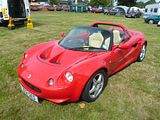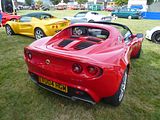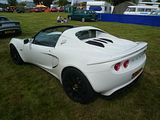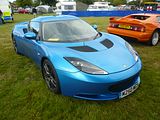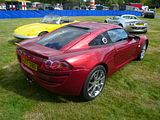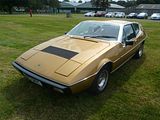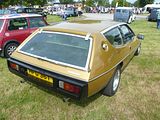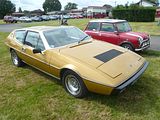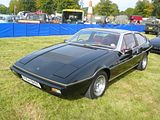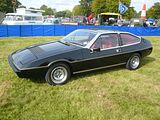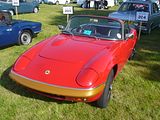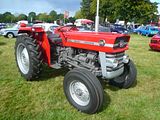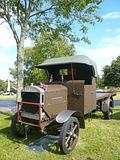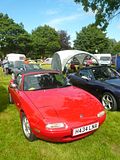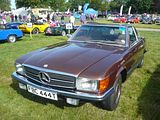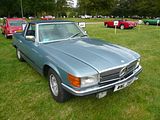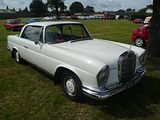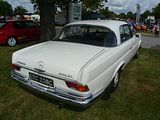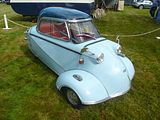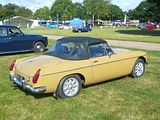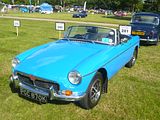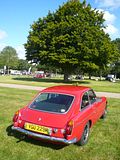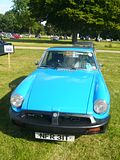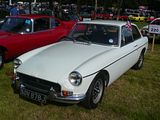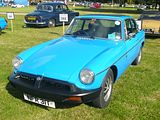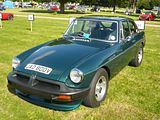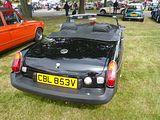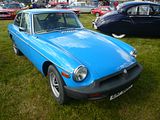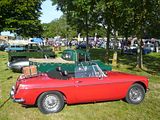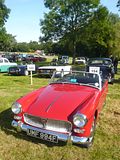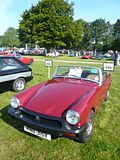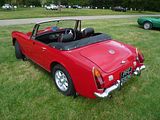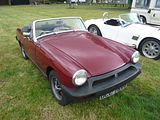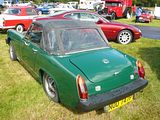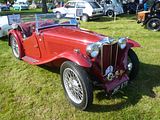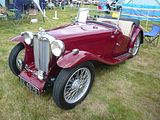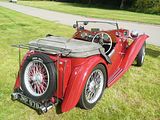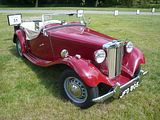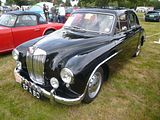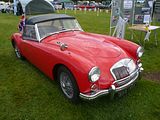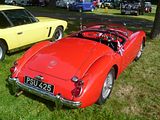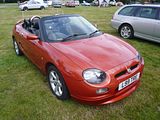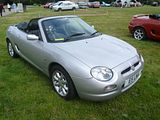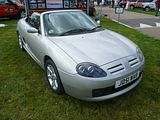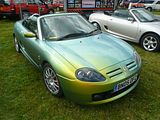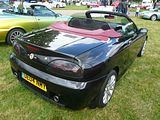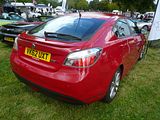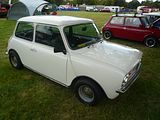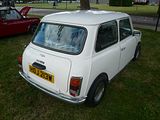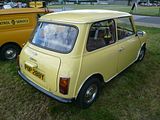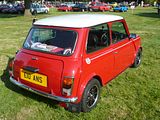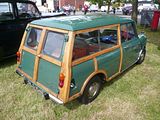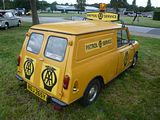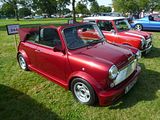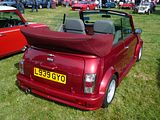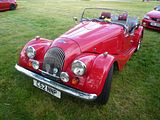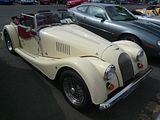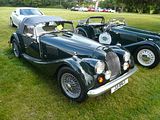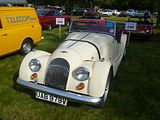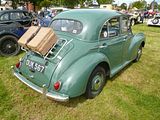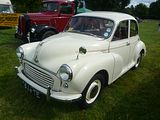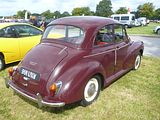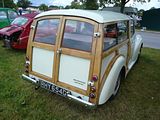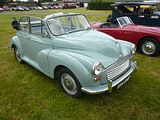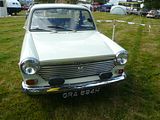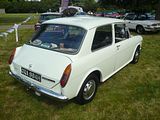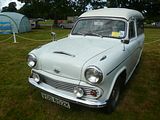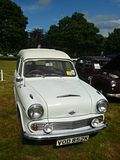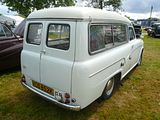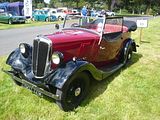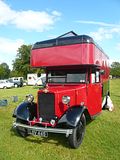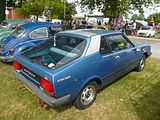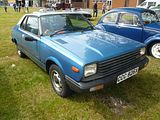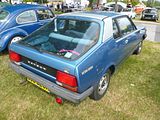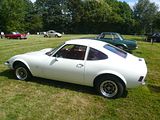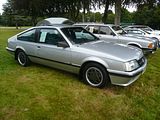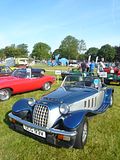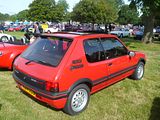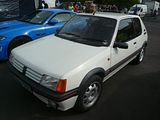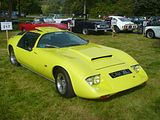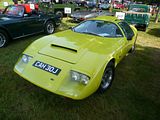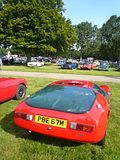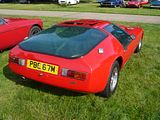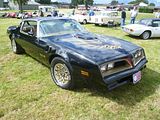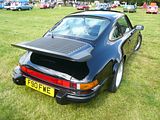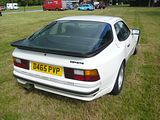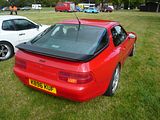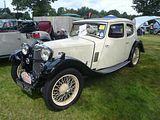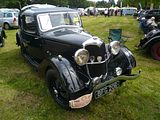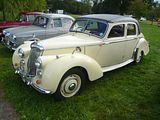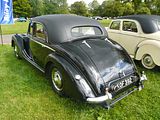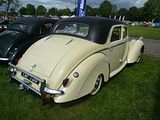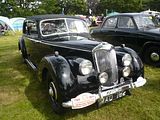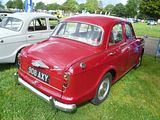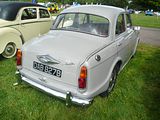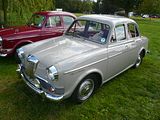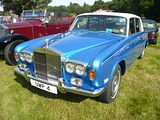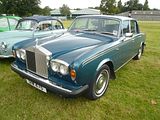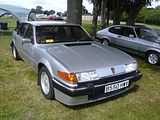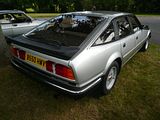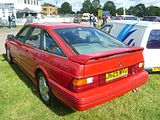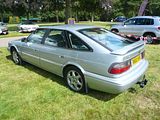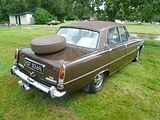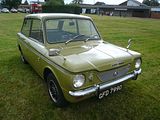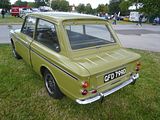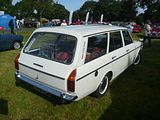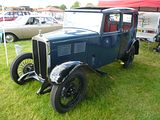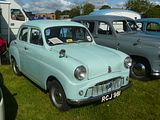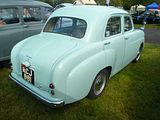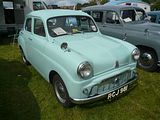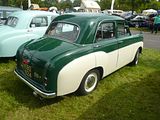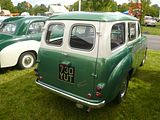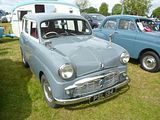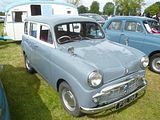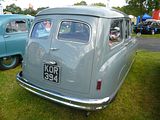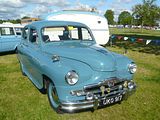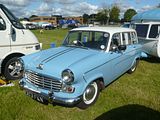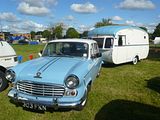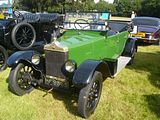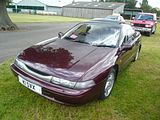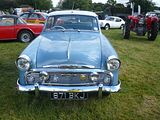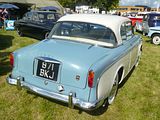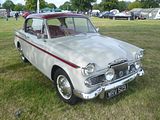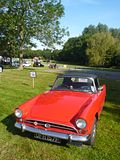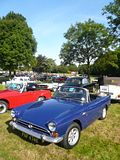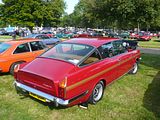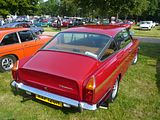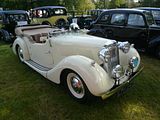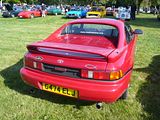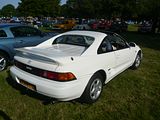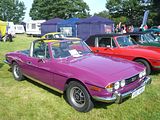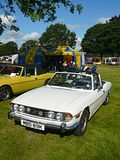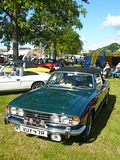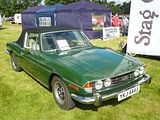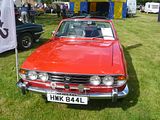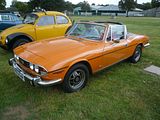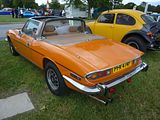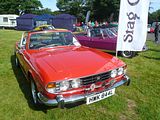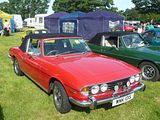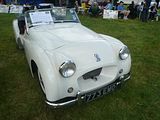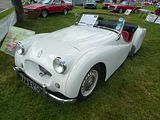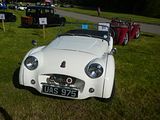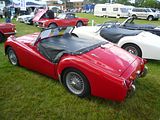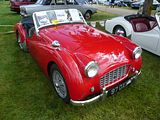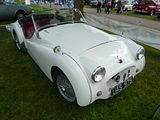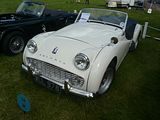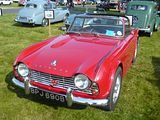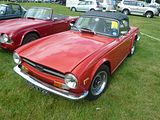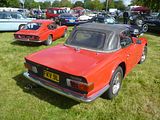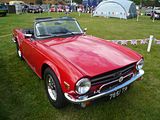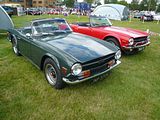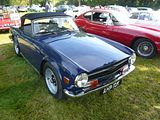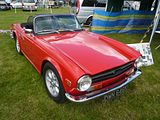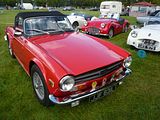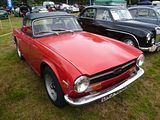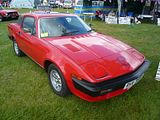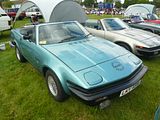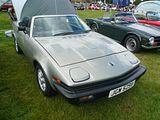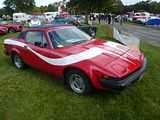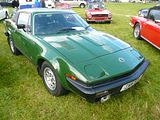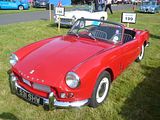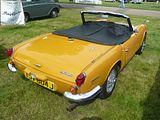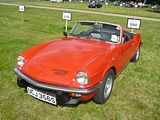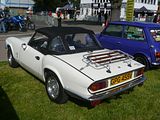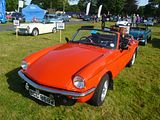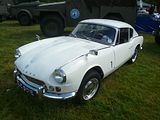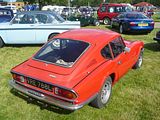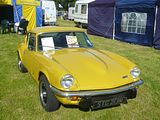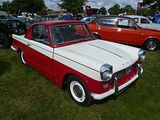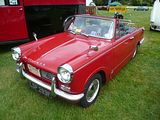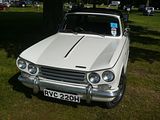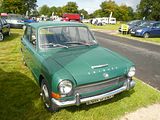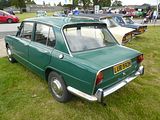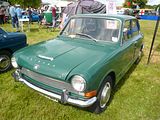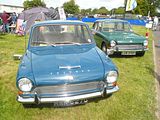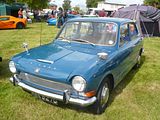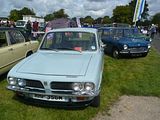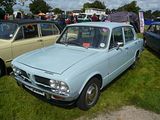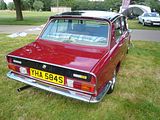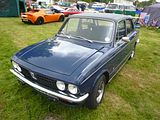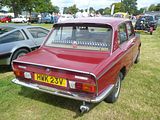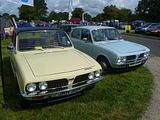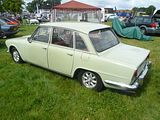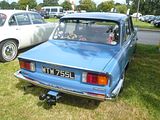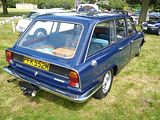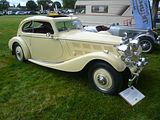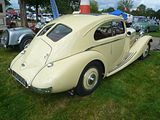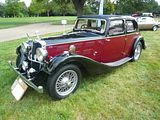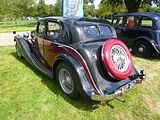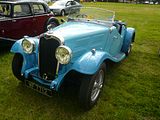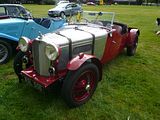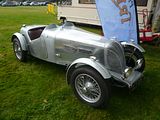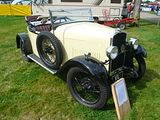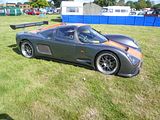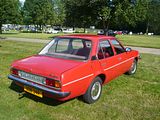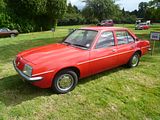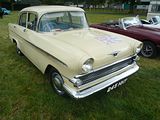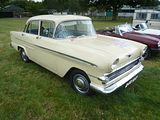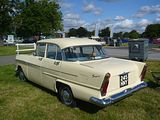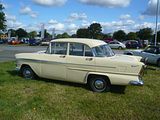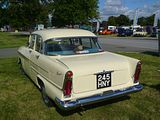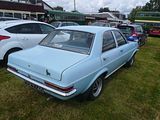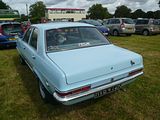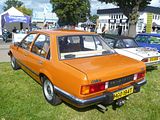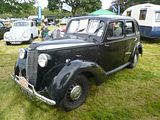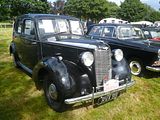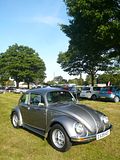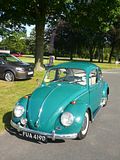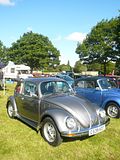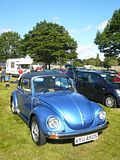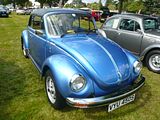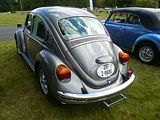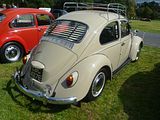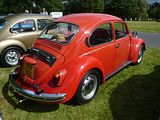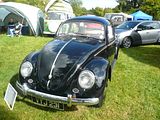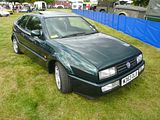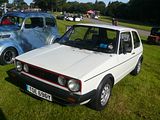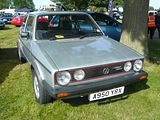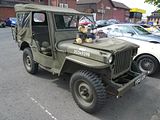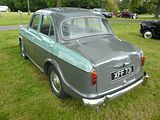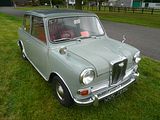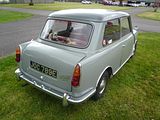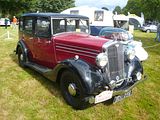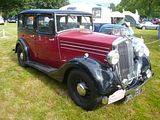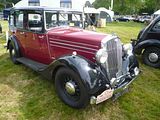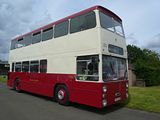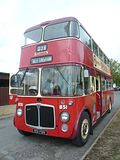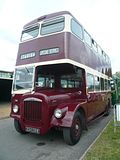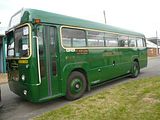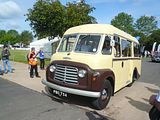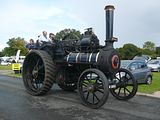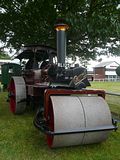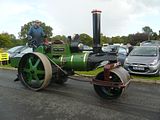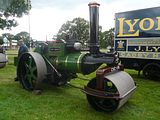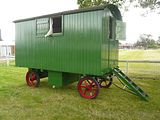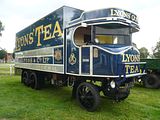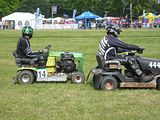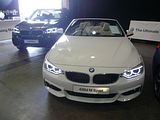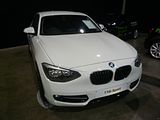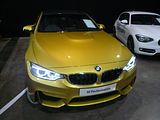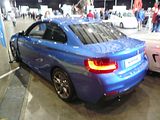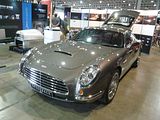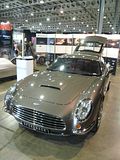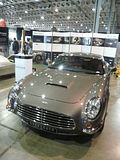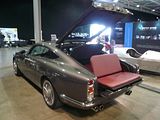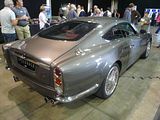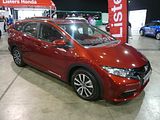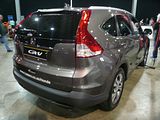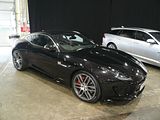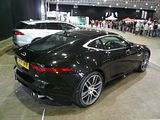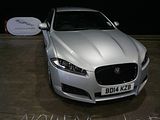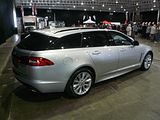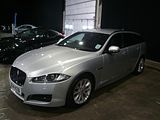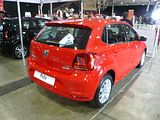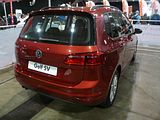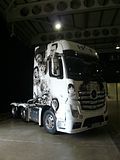I first “discovered” the Coventry Festival of Motoring a couple of years ago. It turned out that it been running for many years prior to that, but had somewhat outgrown the space available, in the centre of the city, based outside the Motor Museum, so in 2012 the event was moved to the much more accommodating surroundings of Stoneleigh Park, a vast area with plenty of room for hundreds of cars, bikes, a display arena, trade stands, a fun air, and enough indoor halls for those exhibits which are better being kept indoors, and that is exactly what you get at the Festival. The event runs over the Saturday and Sunday of the late August Bank Holiday, and the best bit is that it is completely free to enter. To be strictly accurate, there is a nominal charge for public car parking, but if you had chosen to come on one of the frequent shuttle buses from the city centre, then it would indeed cost you nothing. Saturday is the less busy day of the two, though many of the displays are in place, so those whose diary calls for them to be elsewhere should not think that the event is not worth visiting, as it is. On Sunday, though, those who have chosen to enter for a drive around the Warwickshire countryside all assemble early in the morning, and then at 10:30am are flagged off, in sequence, returning when they have completed either the marked out route they were given, or been elsewhere. It takes well over an hour to get all the cars out, and this is a sight (and sound well worth hearing), with commentary from a voice familiar to those who frequent venues such as Prescott and Shelsley Walsh. Even with those 400 cars off campus, there was still plenty to look at, and then by early to mid afternoon, there was a second chance to see many of the cars again. The net of 2 days at the event means a lot of photos – nearly 600 – as there were a lot of cars and other forms of transport to enjoy. Read on:
OPENING THE SHOW
The Lord Mayor, and yes, that is the correct title, even though the current holder of the office is female, arrived on the Sunday morning and officially opened the event. She stayed for a little while, and saw the first few cars head off on the countryside tour. She arrived in a convoy of two cars: the current Mayoral Jaguar, which looked very splendid, as the latest XJ does, and part of the mayoral party also used a truly amazing 1930s Daimler.
DISPLAY CARS
ABARTH
Not the largest meet of the year for Abarthisti, but I did manage to assemble a few, and varied cars for our display area on both days. As well as my own car, now over 4 years old, there was a chance to see Ed Tan’s recently acquired and third consecutive model, a 595C Competizione, as well as mix of other 500, 500C, Grande Punto and Punto Evo models.
Star of the display, as ever, as Mike Foster’s 1000TC. He had not been on the Abarthisti forum for a while, and so was unaware that I had booked a display area, so I first saw his car parked up on the other side of the venue, but I managed to find him and suggest he might like to bring his classic Scorpion to park with its younger stablemates. He took no persuading.
AC
Cobra replicas have a habit of appearing at most shows of any size, and this one was no exception.
Far rarer was an example of the Greyhound, a short lived 2 litre Coupe that AC offered from 1959 to 1963, during which time. 83 examples were built. It was based on the familiar Ace and Aceca cars, but with a stretched chassis to make room for two rear seats. As with the Ace, buyers had a choice of engines, with AC’s own 4 cylinder as well as the Bristol 2 litre engine and 2.6 litre Ford Zephyr unit also being options. All bar three of the cars were right hand drive.
ALFA ROMEO
There were precious few Alfas at the event, but this bright green Montreal did stand out. It was not in perfect condition, but still looked very striking indeed. One of the (many) cars I would not have minded driving away.
Also very nice was this 1600 Spider “Duetto”.
ALPINA
This Baur converted E21 based Alpina C1 convertible is believed to be unique in the UK. This car was apparently rescued from a scrap yard and lovingly restored to the fine condition in which it is now presented.
ALVIS
Alvis sold a range of sports luxury models in the 1930s, cars like this elegant Speed 20
There were a couple of examples of the last production model that Alvis made before abandoning passenger car production in 1967, the TD, and its slightly modified later TE21 version
ARMSTRONG SIDDELEY
One of those marques that is largely forgotten now, Armstrong Siddley produced a range of luxury cars that sat above the likes of Rover and competed with the Daimler in the market. Production ceased in 1960. A number of models were on show. Several of them were Sapphire models, the last major design that the company produced including a very rare factory produced pickup.
Among the earlier cars were some of the saloon model produced in the late 1940s, the Whitley as well as a couple of pre war models.
AUDI
Definitely a rarity, this was a first generation Audi 100, from the time when Audi sold only a small number of cars, as the brand was not well known, and people were suspicious of the fact that it only had an 1800cc engine when all its competitors were at least 2 litres. Nonetheless, this front wheel drive saloon laid the foundation for the marque that we know and buy in huge quantities these days, so it is an important car historically.
It was nice to see an example of the urQuattro too.
AUSTIN
The A70 Hereford looks, at a quick glance, very much like the more common A40 Somerset, but if you look again, you will spot that it is a physically larger car, and the extra wheelbase, evident when you see the distance from the front wheel to the front door which was need to accommodate the inline six cylinder engine in place of the shorter 1200cc B Series engine that featured in the Somerset.
Austin’s small car, the A30 was launched in 1952, as a rival to the Morris Minor and Ford Anglia. A more powerful version, the A35, arrived in 1956, and is easy to distinguish from its revised grille and larger rear window. On show here was an A35 Saloon and an A35 Van
Austin’s family car offering in the 1950s and 1960s took the Cambridge name. Two distinct generations were offered, both of which received a mid–life refresh. The first cars, A40 and A50 had rather rounded styling which was made to appear longer when the revised A55 model appeared. Successor was one of the ranges that was designed by Farina for BMC, with the A55 also sporting the then popular tail fins until the 1962 modifications which added a larger engine, creating the A60, and revised styling. On show here were an A50 and a Farina A55.
The larger A110 Westminster was also a Farina styled car. Many of these cars met their end on the banger racing circuit, so it is always good to see a nicely presented car like this one.
Example of Britain’s best seller of the 1960s and early 1970s was this Mark 2 Austin 1100.
When BL launched the ADO71 model in March 1975, it was branded the 18-22 Series, with individual Austin and Morris cars called 1800 or 2200 depending on engine size and the top of the tree Wolseley called just that with no model name at all. That lasted for just 5 months before the Princess moniker was applied to the Austin and Morris versions and the Wolseley was deleted. This is one of those early Princess cars.
Sole example of the “baby Austin” from the 1920s was this Austin Seven Special
This six cylinder 1930 Austin Twelve was nicknamed the Heavy Twelve, because, well, it was heavy.
It was a follow on to the earlier Six, and there was one of those on show. as well.
The Austin Champ was the civilian version of a British Army vehicle made by the Austin Motor Company. The army version was officially known as “Truck, 1/4 ton, CT, 4×4, cargo & FFW, Austin Mk.1” however the civilian name “Champ” was universally, if unofficially, applied to it.
Designed for the US market, where it flopped quite spectacularly, the Metropolitan was made by BMC, and featured the B series engine under the bonnet. The bright colour schemes were absolutely in line with the fashions of the time, but the anaemic performance was not. A number were sold in the UK and they make for a very colourful sight when they appear now.
AUSTIN HEALEY
Although I am sure there were more Austin Healeys present than this, the only one which I seem to have photographed was this Sprite Mark 2
BEDFORD
Not that long ago, the Bedford HA van could be seen on every street corner of Britain, many of them painted in bright yellow and bearing the BT logo just like this beautifully presented example. With a W plate, dating it from around 1980, this is one of the last examples of this very long running model.
BMW
This BMW Isetta 300 was a real attention grabber, as indeed such cars always are, wherever they are displayed. we can mock now, but the reality is that cars like these, the sale of which BMW licensed, were what kept the company afloat in the 1950s when its own products, the 501/502 Baroque Angel and the supremely expensive 507 sports car sold in such tiny numbers. Without the Isetta, there would be no BMW today.
Another important car in the build up of BMW was the 02 series, This is a late model 1602.
There was a BMW Owners Club display as well. Sadly, this just reminded me of why I do not attend their largest annual gathering, the BMW Festival at Gaydon, as most of the cars here had been, erm, modified. 3 series were dominant, and there were a couple of more or less original cars.
There was a new M4 as well. I am sure that this was actually a dealer car, but the person who had the key did start it up for us, which proved that the press are missing something, as there is nothing wrong with the sound of it, especially if you stand at the rear of it. He tried to tell us that you could buy one without options for £52,000 (I doubt it!), but that it will be expensive to run. As an example, the sump holds 7 litres and the cost of oil to fill it would be £150., Ouch!
He actually said that he preferred the 1M Coupe as a fun car to drive, and even the 135i Coupe which he had also brought along, he said, was a cracking driver’s car. I believe him.
BUICK
Still sporting the vast chrome grille with “teeth” that epitomised American cars of the early 1950s was this 1953 Century model.
CARAVANS
Although we all get frustrated by caravans being towed down the country roads in tourist destinations, and we tend to laugh when Top Gear destroys yet another one, when it comes to historic ‘vans, then our curiosity is piqued, so this display of caravans from the 1920s through to the 1950s was one of the more popular of all the club displays. The owners had certainly taken their time to make an impressive display not just of the ‘van itself but to furnish the inside with period items as well.
CATERHAM
The SP/300 is really intended to be a track car. Production is limited to just 25 units a year, so this is a rare sighting.
CHEVROLET
The C2 model, first launched in 1963, ran for 5 years and was a dramatic departure from the first Corvette.
The C3 Corvette ran from 1968 to 1983, during which time it received more or less an annual facelift. This one dates from the late 1970s.
CHRYSLER
1956 Windsor.
Wind the clock on to the end of the 1960s, and the cars have got even larger. This is a Newport form 1969.
CITROEN
Last year there was a strong showing of small Citroens, but this time there were just a couple of the familiar 2CV to represent the marque.
DAIMLER
The Majestic was a careful update to the Conquest model that Daimler had launched in the early 1950s. This ran from 1958 until well into the 1960s.
Produced by the Daimler organisation prior to its acquisition by Jaguar, the SP250 “Dart” sports car soon found itself with an in-house rival that was favoured by almost everyone. Issues with its novel fibreglass body and cooling problems with its small capacity V8 engine did not help matters, but these have long since been fixed, and the car now has quite a following. Well known motoring personality Quentin Willson has owned his for 30 years and always speaks highly of it.
The V8 250 was a sister model to the much loved Jaguar Mark 2. Launched in 1962, it featured Daimler’s own small capacity 2.5 litre V8 engine, as used in the SP250 “Dart” sports car, initially only coupled to an automatic gearbox, though a manual option did later become available. The car apparently had quite a different character from its Jaguar sibling.
A car that did not have a direct Jaguar equivalent was the DS420 Limousine. Built in small quantities from 1968 for around 20 years, these cars were often used for dignitaries, such as the Lord Mayor. A couple of them were on show at this event on the Sunday.
DELOREAN
DE TOMASO
This Pantera was parked up with the Sporting Bears, and indeed was by some margin the most interesting of the cars that they appeared to have on site.
ELSWICK
This is an Elswick Envoy, a small car that had its origins in the Minissima, a small concept city car that was designed by William Towns as his idea for a replacement for the Mini in 1972 and displayed by BLMC on their stand at the 1973 London Motor Show after buying the prototype from Towns. In common with the Mini it was designed around 10″ wheels and the BMC A-Series engine. It is 30″ (75 cm) shorter than the Mini and designed to park end-on to the curb (like the Smart Fortwo), having only one door – at the rear. It has four seats, two at the front, front facing, and two facing inwards at the rear. The Minissina design re-emerged a few years later as a prototype car for the disabled, adapted by engineering firm GKN Sankey by ex Ford engineer Fred Hart. During the engineering process, the layout changed to feature a central driving position in which a wheelchair user would enter through the back door using a fold-down rear ramp, and drive off. The styling was simplified by William Towns to suit mass production and won a Design Council award in 1978, It did not gain government support due to high costs and the project was cancelled. GKN sold the rights to British bicycle manufacturer Elswick, and a small number were manufactured from 1981 to 1987 and were sold as the Elswick Envoy.
EMERGENCY SERIES VEHICLES
A nice display of historic vehicles once used by our Emergency Services contained mainly former police cars, but there was also a Fire Service Mercedes van which had seen service in the Highlands and Islands of Scotland.
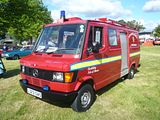
Police cars on show were a mixture of motorway patrol cars, such as the Vauxhall Senator and Omega and the Volvo 850 Estate which once caused all our hearts to miss a beat or two when we spied them coming up behind us at speed, as well as the “panda” Morris Minor.
FERRARI
No surprise that when this F40 arrived early on the Sunday, it really pulled in the crowds. One person just stood there and told me that he might be there all day. just in awe of his dream car. He was not, as the F40 went out on the countryside run, but it did come back, and once again, so did the crowds.
The only other Ferrari model on show was a 550 Maranello.
FORD
Ford does not have any specific connections with the Coventry area, which is perhaps one reason why there were not that many classic Fords on display, even though this brand usually has a good representation at an event like this. There were some interesting old Fords, of course. Among them were some of the “car you always promised yourself”, the Capri, a sporty Coupe based on the prosaic Cortina underpinnings that ran from 1969 to 1986. Among these were a number of Mark 1 cars which included an early car, a RS3100, a facelifted Mark 1 Capri. There was also a late model Mark 3.
This Mark 3 Cortina 2000E was the top of the range of what by 1973 had become Britain’s best seller and would have been the envy of many a motorist who was driving around in one with L trim, and a far less powerful engine. Never mind that the camshafts on these early 1970s Cortinas had a notoriously short life, what mattered was the vinyl roof, and all the extra time features which told everyone you had a top spec car! There was also an earlier GXL model, the top of the range nomenclature used form 1970 to 1973.
The 2000E badging was introduced in the 1973 facelift as a reminder of the much loved 1600E Mark 2 Cortina which was produced from 1967 to 1970.
2000E had been used on the top of the range Corsair prior to that. Ford’s upper medium sized saloon, dating from 1963, never found anything like the popularity that was enjoyed by the Cortina, though. Not much larger than the Cortina, it was no real surprise that when the time came to replace it, Ford simply declared that the larger engined Cortinas were the successor.
Ghia was the top of the range moniker used by the time of the Mark IV Cortina, such as this one.
Mark 1 Cortina was not forgotten, either, as this example shows. This is an early car, as you can tell because the side lights are separate from the grille, something which changed during the model’s life.
Zodiac was the top model in Ford’s large car range, running from the introduction of the Mark 2, in 1956, through to the end of the Z cars in 1972. This is a Mark 3 car, made between 1962 and 1966.
Mark 2 cars were represented by this Consul, the four cylinder model in the range.
The Z cars were replaced by the Granada range in 1972, and a second generation model arrived in 1977. Facelifted cars with more substantial bumpers arrived in 1981, and ran through to 1985 when a very difficult looking model appeared. This is a high end facelifted Mark 2 Estate model in top of the range 2.8 GhiaX guise.
There was a complete stand with a wide variety of sporting Fords on it. Some were, erm, modified, but there were plenty of interesting cars that were more or less standard, and even a couple that looked less than sporting. Rarest, not least because it was never sold in the UK, was a Sierra XR8. This had a 5 litre V8 unit squeezed under the bonnet and was offered to South African buyers in the 1980s.
In complete contrast was this very basic Anglia Van. Staple of small businesses and utilities in the early 1960s, these were completely devoid of any creature comforts at all.
More recent, but now a rare sight, was this XR3i Cabrio. This was one of the first convertible models offered for quite a long time, and followed the success of VW’s Golf Cabrio, which was also built by German specialist Karmann.
Earlier Escorts were here, too. Among the Mark 1s was this nice Mexico and a Mark 2 RS2000.
Pre-dating the Escort were the Anglia and Prefect, and this is one of the “perpendicular” style models that were made in the late 1940s and early 1950s. Anglias were two door cars and the Prefect had four doors.
A new generation of these small cars was launched in 1953, and the range also included Estate models, which were called Escort and Squire. The latter was the more costly of the two and had a small piece of wood trim on the side in reference to the “woodie” style of US Station Wagons from a few years earlier.
American Fords were also on show, with the 50th Birthday Boy, the Mustang represented by a couple of early cars and a slightly later Shelby model.
There were a couple of Model Ts present.
Although the first European Fords were based on the American models, it was not long before locally designed models were produced, so Ford’s UK and German ranges diverged from the US cars during the 1930s. This is a 1930s German tourer.
XR2 Fiestas don’t tend to survive, as many get modified and then destroyed either by over exuberant driving or because the mechanicals upgrades were simply too much and they destroyed too much of the basics, so it was good to come across this example of the facelifted first generation and the second style of Ford’s long running and popular supermini.
Bringing things right up to date were some ST models, Fiesta and Focus.

GINETTA
There were a couple of G33 models here.
HILLMAN
The Hunter was the Rootes Group answer to Ford’s Cortina. Slightly more expensive than the Dagenham product, it never enjoyed anything like the same success in the sales charts, even though many – my father included, who had 4 of them – believed it to be a superior car in many ways. Of course, it had a much longer production life if you include the Paykan versions that were made and sold in Iran until very recently indeed. This is one of the very first models, made in late 1966.
Wind the clock back ten years and you get to the Audax based range of cars. The mainstay of the range, of course, was the family-sized Minx, but for those who wanted a versatile and relatively cheap carry-all, Hillman took the Commer Cob van, and put a rear seat and side windows in it, and called the result the Husky. I’ve seen this car before at this event. It has been in the same family since new, and has still only covered 40,000 miles in nearly 60 years. It is in original and very good condition.
Early Super Minx cars had wrap round front and rear screens as was the fashion in 1961 when the model was first launched, but later models had revised styling with straight pillars as well as a larger 1725cc engine.
The Minx name dates back to the early 1930s, and this was a nice example of one of those pre-war cars, seen here in open topped guise, a 1936 car.
HONDA
Whilst we wait for the long promised and much delayed new NSX, there was an example of the first generation car to remind us of why we are so expectant. Let’s hope that Honda recreate the same sort of magic as they did with this one.
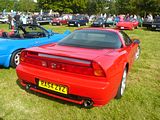
The third generation of the CRX was very unlike what had gone before, with its intriguing metal roof which folds away under the boot lid following what looks like quite a performance, lifting it up and back on stilts.
HUDSON
A long obsolete brand the Hudson Commodore of 1950 was particularly futuristic looking with its streamlined styling.
HUMBER
When production resumed after the cessation of world hostilities, Coventry marque Humber concentrated on the luxury end of the market, and the result was cars like this, a Pullman from the late 1940s.
The last true Humber design was the Hawk model that appeared in 1955, and which quickly gained a more powerful and luxurious stable mate, the SuperSnipe. This is a relatively late example of the latter.
In 1963, a smaller Humber, the Sceptre was launched. Based on the Super Minx, this design had originally been intended to replace the Rapier, but instead, Humber offered it as a sports/luxury saloon rival to the Rover and Triumph 2000, both of which were launched at the same time.
JAGUAR
This brand new F Type Convertible was generating lots of interest. I think almost everyone agrees that this car recaptures much of the magic and the “want one” that pertained to the E Type over 50 years ago. It really is a stunning car to look at, and it sounds even better than it looks.
Hard to believe that the XK8 is now nearly 20 years old. This car is also, by common consent, a good looking car, and it became an instant classic almost before production ceased.
A well known car, this XJ40-based car saw service as the Fire Tender at Donington race track for a number of years before taking its retirement as an exhibit in the Coventry Motor Museum which is where you can usually see it.
Jaguar launched a smaller car to expand their range in 1955. It was called the 2.4, and came with drum brakes (!) and enclosed rear wheels, as this one shows. A larger 3.4 engine was fitted a couple of years later, and then it was facelifted to make it the Mark 2, now a legend in Jaguar’s back catalogue of desirable motor cars. Only the purists would probably enjoy this particular one, though!
There were examples of the later Mark 2 on display as well, as to my eyes, this is one car where the facelift was a significant improvement.
Another of the cars from the Coventry Museum was this XK120, a famous ex-works car.
A number of other XK models appeared on the Sunday for the countryside run, with XK120, XK140 and XK150 cars all represented.
No display of Jaguars would be complete without an E Type or two, and needless to say, there were several throughout the event, with owners cars as well as one on the Jaguar heritage stand.
This was not a genuine D Type, sadly, but a well produced replica.
Completely separate from all the models depicted above was a collection of XJS cars, with a variety of models ranging from an early car to some of the later Cabrio and Convertible models.
The Coupe versions of the XJ6/12 models had a short life, running only from 1975 (though announced in 1973) to 1977, which is a pity as they are supremely elegant. There were a couple of these highly desirable cars here including one of the XJ12C models.
There was a very nice Mark 2 XJ6 Saloon as well.
Hard to miss, thanks to its bright blue paint finish was this XKR-S.
JENSEN
Interceptor
LANCHESTER
The Lanchester Ten, also known as the LD10, produced after the Second World War was presented as a compact companion model to the Daimler range, being “craftsman built” and among the smallest ever volume-produced cars from the firm. It was initially produced with a steel six-light body by Briggs Motor Bodies of Dagenham though this body suffered from erratic deliveries by Briggs and rust problems due to the grade of steel allocated by the government for their manufacture. From September 1949 the same chassis was instead fitted with coachbuilt Barker aluminium alloy sports saloon bodywork. Other body variations included an Abbott-bodied drophead coupe and Hooper-bodied van. It had a four-cylinder engine with a claimed power output of 40 bhp at 4,200 rpm, which was coupled through a fluid flywheel to an epicyclic preselector 4-speed gear box. The car was considered to be exceptionally smooth in operation, with reasonable performance for its time. There were a couple of these cars at the event.
LAND ROVER
Another “local” product, the Range Rover has now acquired a classic status, and the very early cars go for literally unbelievable sums of money when sold. One of those pre-production cars, known as the Velar, was here, following restoration from a rather tatty state in which it was found. It was joined by a number of other models showing the Rangie evolved from what now seems like a rather basic and utilitarian vehicle with two side doors to the longer wheelbase 4 door luxury models that were produced in the early 1990s before the less well liked P38 models arrived to replace the first model. There were a couple of those, too, including an authentic former police car which was actually used at Princess Diana’s funeral, and which therefore has a special place in many people’s hearts.
A separate display was specifically for G4 Challenge vehicles. The Land Rover G4 Challenge is a global adventure competition. The spiritual successor to the Camel Trophy, it has off road driving at its core, and it has taken place a number of times in recent years. The first was in 2003, with 16 participating nations and it traversed the USA, South Africa and Australia over the course of 28 days. It was won by Belgian fighter pilot Rudi Thoelen. Rudi declined the prize of a brand new Range Rover, opting instead for two new Defenders. The Team Spirit Award was won by Tim Pickering from the UK, this award was given by the other competitors for the person who in their view contributed most to the race. In 2006, 18 nations participated in the event which was staged across Thailand, Laos, Brazil and Bolivia. Land Rover delivered a more vehicle-focused event in 2006 after some criticism that the 2003 event focused too strongly on the adventure-sports element. South African adventure racer Martin Dreyer was the eventual winner. The next one was planned to take place in 2008/9, but this one was cancelled owing to the prevailing economic downturn. It had been planned to run the event in support of the International Federation of Red Cross and Red Crescent Societies. It is unclear whether the G4 Challenge will ever run again. On both occasions that it did, a wide variety of different Land Rover vehicles, all painted in distinctive Tangers Orange were used, with Defender, Discovery, Freelander and Range Rover all taking part, meaning there was plenty of variety to see on this stand.
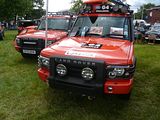
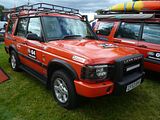
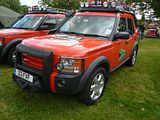
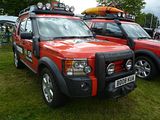

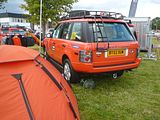
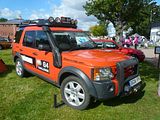
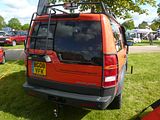

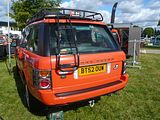
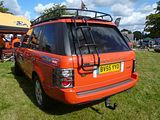
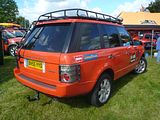
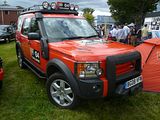
Land Rover themselves had a display area just outside the main exhibition halls. As well as offering (very booked up) Land Rover Experience rides, they had a number of show cars, ranging from an early Range Rover to one of the hard worked prototypes of the very latest model, still wearing the camo that it sported when out on public roads. Most of these prototypes get scrapped, but this one has apparently been acquired by a museum, though the stand representative did not say which one, so it will be seen by many for years to come.
LOTUS
The Lotus Owners Club display had a wide variety of cars on display from the early Elan and Plus 2 through the Esprit to more recent Elise, Exige and Evora cars. There was also one of the little loved modern Europa models.
Latest offering, and one which you do see often enough to be convinced that Lotus have made more than just the press fleet, is the V6 engined Exige. Not a thing of beauty, this is apparently a great car to drive, and probably a better proposition than the pricier Evora.
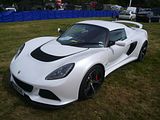
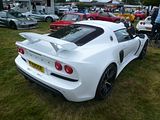
From Lotus’ “wedge” era, you tend to see the Excel cars most frequently, with the car which started off the range the Elite being far rarer, and the coupe model, the Eclat rarer still. So it was good to see both of these here.
There were some further Lotus cars in the area occupied by all the cars that duly headed off on the countryside tour.
MASSEY FERGUSON
Doyen of many a British farm in the 1960s, the Massey Ferguson organisation resulted from the merger of the Ferguson company with Massey Harris. Ferguson was a local company, founded by Harry Ferguson in the 1930s , which enjoyed much success with the iconic little grey machine which was first launched in 1946 following an agreement to build the machine in Standard’s manufacturing plant. Over half a million had been made within a ten year period. By 1957, Ferguson had sold his interest in he company, which was then owned by Massey Harris. The name Massey Ferguson was adopted in 1958, and new products appeared on a frequent basis, generally getting larger with every new model, with the very last Massey-Ferguson tractor to be made in Coventry, being built in 2002.
MAUDSLAY
Now a resident of the Coventry Motor Museum, this is the last survivor of a number of Maudslays that saw service in the First World War. An ambitious restoration program has been going on in the past few months to try to have the vehicle ready for the various commemorations of the centenary of the War in which it served.
MAZDA
MX5 Owners are a sociable lot, and they tend to appear in some quantity at events where the club is booked in. This was one such, and of course, this being the 25th anniversary of the launch of the world’s best selling sports car, they did not miss out on the opportunity to remind us of that. All three generations of this much loved car were on show.
MERCEDES-BENZ
This splendid “Pagoda” 280SL would have been a particularly nice car to take on the Warwickshire country lanes tour, though it would need the roof removing first. That. I believe, is not quite such an easy task, and certainly needs two people to lift it off.
Follow on car was the R107 model, and these are now appreciated for their classic good looks and robust engineering, as indeed they deserve.
Another highly desirable Mercedes was this 280SE Coupe from the early 1960s., Very elegant indeed.
MESSERSCHMITT
The Tiger models were as petite as the other microcars of the 1950s, but these had a decidedly sporting bent, and would – if the driver was brave enough – go surprisingly quickly. These days they are a real attention grabber.
MG
There were lots of MGB models, all of ages from some early cars right through to late rubber bumper models, with a mix of Roadster and GT cars as well as the six cylinder MGC.
The smaller Midget is also extremely popular, and there were plenty of these, showing the evolution of the model from the early cars with chrome grilles, through the later black grilled cars to the last of the line with the ungainly rubber bumpers and with – much to the initial disgust of the marque’s afficianados – the 1493cc Spitfire engine under the bonnet.
MG really came to prominence with the TC model that they offered after the war. It was recently demobbed GIs who had seen the pre-war cars in Europe whilst they were on duty and who wanted one to take back to America who fuelled the demand, meaning that MG made more TCs than all models that they had produced prior to it. A number of those cars have, of course, since come back to the UK. As well as TCs models, this event also featured some of the follow on cars, the TD.
MG’s sports saloon of the mid 1950s resurrected the Magnette name. Sharing a body with the Wolseley 4/44, this is the sort of car that today’s 3 Series driver would have aspired to in 1953.
The T series ended in 1955 with the launch of the MGA. Looking very different from what had gone before, these cars have plenty of appeal with their elegant styling, and although the early 1500cc cars were not fast (something addressed with the more powerful engines that appeared over the next 7 years), they are a lot of fun and so remain popular nearly 60 years on.
The MGR V8 was a short lived model made in the early 1990s, as a prelude to something more significant from MG. Many of these cars were initially exported to Japan, where it was especially popular, but plenty of those have since returned to these shores.
The more recent MGF and TF are very popular with enthusiasts, and they do represent an excellent “starter classic”. Several were on show here.
Also present was an MG6. At all events I’ve been to this year, there seems to have been an MG6 or two in among the classic MGs, indicating that the very latest car has at least to an extent been accepted as one of the family and that whilst this is still a very low volume seller, there are enthusiasts for the car.
MINI
Classic “Issigonis” Mini was of course represented, with a number of cars including one of the last Clubman saloons made, and a nicely presented Van in AA livery.
Rarer even than the van was one of the small number of factory approved Cabrio models that were made in the early 1990s.
MORGAN
The Morgan Owners Club had a number of this evergreen British sports car on their stand. Look carefully and you can see an evolution over the last 50 years, but there is clear lineage there, too, as an early Plus 4 model shows when compared with the much more recent Plus 8 cars.
This is an example of the original 3 wheeler, from the 1930s rather than the recent recreation.
MORRIS
Another staple of the “affordable” classic car world is the long-lived Minor, and there were several of these at the event, including both open-topped Tourer and the practical Traveller as well as the Saloon, which was to be seen in early MM guise as well as the later 1000 guises.
Intended as a successor to the Minor was the ADO16, the Morris 1100. However, this front wheel drive Issigonis masterpiece appealed to a different sort of customer, and the two model ranges ran in parallel for nearly 10 years. This is a Mark 2 car.
This was the only Marina I saw at the event. a 1300 Super, with the rare automatic gearbox, it is a real period piece, complete with the once popular optional vinyl roof.
BMC produced a light commercial vehicle based on the Farina range, with van and pick up vehicles that were quite popular and had a longer production life than the saloon and estate cars on which they were based. A number of specialist companies took the van as a base for a small motor caravan, as this was quite popular at the time, and this is one of those, a TorCars conversion. I remember these quite clearly, as one of the near neighbours to me when I was growing up had one, and we used to be packed into it, along with lots of other children from the street and taken to Scout or up Cleeve Hill for an afternoon out. Most of them bore Austin badges, but the last cars were labelled Morris, like this one.
Wind the clock back to pre-war and the mainstay of the range was the Eight, a car which celebrated its 80th birthday earlier this year. This car was offered in a wide variety of body styles including this open Tourer.
Slightly earlier than this, the Morris Commercial was a popular light vehicle which was supplied with a lot of different body styles.
NISSAN/DATSUN
This N10 series Cherry Coupe from 1981 was at the event last year. Coupe versions of all Nissan/Datsun’s products were a feature of the range throughout the 1970s and 1980s, and they sold quite well. Few Japanese cars of any bodystyle have survived from this era, as they were seen very much as appliances rather than future classics when new, so it is good to see this reminder of something that was once quite common on our roads.
OPEL
One of the more unusual cars at the event was this, an Opel GT from the late 1960s. Never officially sold in the UK, this stylish Coupe model took its styling cues from parent company’s 1968 Corvette, but in a much smaller car. Base engine was a rather weedy 1100cc, but you could order it with a 1900cc which at least made it go rather more in accordance with the looks. Not well known these days, you can buy one – if you can find one – for not a lot of money.
Ten years later, Opel launched the Monza, a large Coupe version of the Senator saloon. Well received, the model was facelifted in 1983, and this is one of those cars.
PANTHER
After enjoying modest success with their pastiche designs at the very top end of the market, Bob Jankel’s Panther company decided to offer a cheaper car, which was launched in 1976, and was called Lima. Underpinnings were based on the Vauxhall Magnum, which meant an 1800 or 2300cc 4 cylinder engine, wrapped in a modern body designed to recall a style from the 1930s. It sold in reasonable numbers for five years before a revision, a change to Ford underpinnings and a name change created the Kallista, and something to sell for a further few years. This one is a Lima.
PEUGEOT
A nice example of the 205 GTi
Another one was parked up in the Sporting Bears area.
PIPER
Piper Cars was a UK manufacturer of specialist sports cars and an associate company of a camshaft and engine tuning parts manufacturer of the same name. The company was initially based in Hayes, then in Kent, with production taking place from 1968 at Wokingham, Berkshire and from 1973 at South Willingham, Lincolnshire..The first Piper GT road model, designed by Tony Hilder, was introduced at the January 1967 Racing Car Show and immediately afterwards entered production as a body/chassis unit for home completion. The front engine rear drive tubular steel chassis using Triumph Herald front suspension and Ford rear axle components could accommodate a variety of engines. Problems with the first few produced caused further production to be delayed until the following year when a substantially better developed version was introduced and became known as the GTT. At the same time, a mid-engined Group 6 racing car, the GTR, was being developed but only a handful were produced before this was abandoned following the death of company owner Brian Sherwood in late 1969. The GTR was only 30 inches high, and had a drag co-efficient of only 0.28. Designer Hilder achieved this by moving all the mechanical parts, such as the water and oil radiators to the rear of the car. The car was entered for the 1969 Le Mans 24 Hours Race, but overheating problems and the failure of driver John Burton to record a qualifying time meant that the car did not start the race. Two employees, Bill Atkinson and Tony Waller, took over the company renaming it Embrook Engineering, ceased all racing activity and focused on improving the road cars. In 1971 this led to a further revision known as the Piper P2 with many improvements to chassis, body and interior design. This model continued in production until the mid-1970s. Estimates of total Piper production vary from around 80 (Piper Sports and Racing Car Club) to somewhere over 100. Regardless of the total, these are rare cars and you don’t see them very often, so it was nice to see not one, but two of these cars at this event.
PLYMOUTH
A real period piece of Americana was this 1958 Belvedere.
PONTIAC
A big slice of Americana was represented by both a late 1970s Firebird Trans Am and an example of the model style that replaced it and ran through the 1980s.
PORSCHE
911s, of every generation, are popular classics, so no surprise to find a few of them here.
There were a couple of front engined Porsche present, too, a 944 and the later 968.
RILEY
Prior to their acquisition by the Nuffield Group in 1938, Riley had a vast and complex range of models, most of which had a sporting bias, whether they were saloons or open tourers. Identifying them requires specialist knowledge, but I think these are both Nine Monaco models.
Riley’s first offering in the immediate Post WW2 period was the RM Series. Offered with 1.5 and 2.5 litre engines, this was a sports saloon (yes. honestly), the RMA and RMB. Short lived open models, the RMC and RMD followed, and then facelifted cars, the RME and RMF kept the model fresh until its replacement by the Gerald Palmer designed (and much despised) Pathfinder in 1953.
With the Pathfinder not hitting the spot, Riley dealers were desperate for something else to sell, preferably that customer actually wanted to buy. The design originally intended to be a replacement for the Morris Minor was upgraded into Riley and Wolseley versions, and never made it as a Morris at all. Riley’s version, the more powerful of the two was the OnePointFive and this car enjoyed modest success between launch in 1957 and its demise in 1965.
The Elf was the Riley version of the booted Mini that appeared in 1961 along with the Wolseley Hornet version.
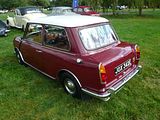
ROLLS ROYCE
When it was new, this Silver Shadow, seen here in both Mark 1 and Mark 2 guises, was thought of as a big car. By today’s standards, it no longer seems so.
Looking suitably imposing was this Silver Wraith, dating from around 1950.
ROVER
The SD1 generated mass enthusiasm and interest when launched in 1976, in a way that is hard to imagine now, as these days, it takes some far more exotic than a large executive saloon to get the Tope Gear generation enthused. Of course, the ownership reality let the side down somewhat, as people soon found out, though Rover did make a number of improvements over the years, trying to address not just the variable, and often terrible build quality but the few other things which the press found to fault. In 1982 they added more excitement to the range with the launch of the potent Vitesse, and it is these versions which have survived in greater number than the more prosaic models. This is a late model car, identifiable by the reshaped front spoiler.
Following the popularity of the Vitesse version of the much loved SD1 model, Rover used the name again on the top of the range sporting models of the XX cars, as well. Somehow they never generated anything like the same affection, so it is god to see that there are at least a few survivors. Here is one.
Follow on to the XX were the R16/17 models, a major facelift rather than a completely new car. These models carried the top of the range torch from late 1991 until the arrival of the all new 75 in 1999.
Wind the clock back to the 1960s and 1970s and it was the P6 that was the mainstay of the range, with the V8 powered 3500 and 3500S being particularly desirable.
The range did also include the P5, a model which ran from 1958 to 1973, and which underwent quite a character transformation when the ex Buick 3.5 litre V8 engine was put under the bonnet in 1967. These cars were popular for official use, with a number being acquired by the Government and stored during the 1970s, thus meaning that they were on duty long after production ceased.
Rover had built their reputation as being the sort of car that your Doctor, Bank Manager of Solicitor would buy with its pre-war offerings, such as this Fourteen.
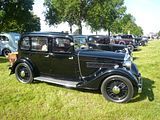
SINGER
The Chamois was the Singer version of the Hillman Imp. Arriving in 1964, a year after the initial launch, it featured higher quality interior trim, and a slightly more powerful engine.
When the Hillman Hunter arrived in October 1966, it did not take long for parallel Singer models to appear, with the Gazelle sitting above the entry level Hillman Minx and the posher Vogue above the Hunter. Estate versions of both were also offered. I have a soft spot for these cars, as we had a couple of Hunter Estates when I was growing up, the second of which was “my” car for a few months when I started work. Ours was not in this condition when it was 11 years old, let alone nearly 50 as this one is!
STANDARD
A local brand, Standard was once the third largest British manufacturer after Austin and Morris. But that was in the 1920s, and although the cars that they launched for some time after that were worthy enough, they just never managed to hold onto that market position. In post WW2 Britain, it was decided that the name was a problem, too, denoting not just “the Standard – by which things should be judged” but to too many people “Standard, as in, not special at all, just standard”, and so the name was phased out gradually to be replaced by the Triumph branding, from a marque that the Standard Motor Company had acquired in 1938. There are still plenty of devotees of the marque, though, and the Owners Club had assembled a varied display of cars for everyone else to see and enjoy.
Oldest Standard in the Owners Club display, and one of two pre-war cars was this one, still a “work in progress” restoration of a 1920s Nine Saloon.
The other pre-war model was the much larger 1934 Sixteen saloon.
The Eight was launched in 1953, as a replacement for the Triumph Mayflower. Deliberately designed to be cheaper in every way, the first cars were extremely basic, though they were the cheapest four door car on sale at the time, listing for £481 at launch. They were too basic, as it turned out, and gradually, some of the features which the market considered important, such as an external boot lid and a passenger sun visor were added, and a more powerful engine appeared making the Ten, which arrived in 1954. A posher model, called the Pennant was added to the range in 1957, sporting traces of the then fashionable tail fins in an attempt to modernise the styling appeal, along with two tone paintwork. A very practical Estate model was also offered, called the Companion. In the 1950s, estate cars were regarded as largely being the preserve of the commercial traveller for whom luxury certainly did not seem to matter. Standard adapted their small car to produce the Companion, which was unusual among its competitors for having four passenger doors. There are very few survivors indeed.
The Vanguard was a large family car, first shown in 1948, one of the first all new post war designs. Styled very definitely like many American cars of the 1940s, early production was aimed at the all important export markets, but gradually the car was made available to domestic buyers. A heavily revised version, the Phase 2 followed in 1953, with the beetle-back replaced by a more conventional cut away roof line, with a separate boot. A completely new model arrived in 1955, the first of a number of cars with links to Italian styling house Vignale. This one ran for 8 years, until replaced by the Triumph 2000 in late 1963, during which time it was offered not just as a saloon but as a practical estate, and a cheaper four cylinder Ensign as well as a short lived Sportsman version. On show at the event was a Phase 1 Estate, a Phase 2 Saloon and a late model Phase 3 Vignale Six Estate complete with period caravan.
A far older Standard appeared on the Sunday morning, this one dates back 100 hundred years.
SUBARU
A real oddity, this, the rather wacky SVX. Twenty years on, it still looks somewhat futuristic.
SUNBEAM
Pre-war Sunbeams were expensive touring and sports cars, and the market for these reduced notably as the Great Depression took its hold. Accordingly, Sunbeam decided to offer a slightly smaller and cheaper car, and this is the result, the Dawn, which was launched in 1934. It only ran for two years before the idea was abandoned
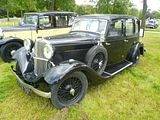
The Rapier was launched in 1955, as the sporting top of the range of Audax based cars that were also offered as Hillman Minx and more luxurious Singer Gazelle cars. It evolved through a series of model upgrades until it was replaced by the Arrow based Rapier in 1967. The car enjoyed much success as a rally car. A very early model was on show, as well as a slightly later car and one of the late model versions.
Sunbeam launched a small open topped sports car to compete against the MG, in 1959. Called the Alpine, it initially took on the MGA, and then had to contend with the MGB from 1962. In many ways, I think I prefer the Sunbeam, always having had a soft spot for the neat styling, especially the later cars when the tail fins had been toned down, and the more refined Rootes Group 1725cc engine had appeared under the bonnet. Of course the version I really like is the one which features a potent Ford V8 under the bonnet, the Tiger, a car that celebrates its 50th anniversary this autumn. This duo were both late model Alpines.
The next car to bear the Rapier name also included an Alpine in the range. Essentially a Coupe version of the Hillman Hunter, this elegant machine found itself competing against the Ford Capri. Although positioned so a model for model comparison was quite difficult, the Ford was generally seen as better value and was certainly far more popular. The Holbay Tuned H120 was a response to the 3 litre Capri, Not that many were sold, so this is quite a rare car, and this one was in splendid condition.
TALBOT
The Talbot name was dusted off in 1979 and applied to the European products that had previously born the Chrysler name. That included the Sunbeam hatchback, which had been launched in 1977. In 1979, though, this humble hatchback was transformed when the Lotus version appeared, sporting the familiar 2 litre Twin Cam Lotus engine under the bonnet. The car was produced to homologate it for rallying – and the car did indeed enjoy massive success in the forests – with the road cars being seen as something of an expensive curiosity at the time. Rust and a tendency to catch fire has wiped out quite a lot of them, but they are still out there and this was a nice example.
TOYOTA
There were a couple of examples of the second generation MR2 in the area of cars that went out on the countryside tour
TRIUMPH
Whenever the Stag Owners Club support an event, they seem to manage to bring along a considerable number of cars, and usually manage plenty of variety in the colours, reflecting the varied palette in which this stylish GT Tourer that was made from 1970 to 1977 was available. The bright colours are my favourite, so Mimosa (yellow) and the bright blues appeal more than the darker shades, but even in hose hues, this is a deeply desirable car now that specialists have figured out how to make them reliable. They still need careful looking after, I believe, but are far less fragile than they were 35 years ago.
There was a very impressive display by the TR Register, as well, with a great variety of cars ranging from TS2, the prototype for what became the production TR2, all the way through to the TR7, including one of the 4 cars that were made as special competition prizes in a CocaCola competition.
The smaller Spitfire was also evident, with a number of examples of this very long running and much loved small sports car here, with early cars as well as the Mark III and later Mark IV models.
The GT6 was little more than a fastback coupe version of the Spitfire, but further differentiation came from the fact that it had a six cylinder engine under the bonnet. Early cars had some rather interesting handling characteristics, thanks to the continued use of the rear swing axles, but Triumph did tame this before upgrading the power in the subsequent Marks 2 and 3. There were examples of the Mark 1 and Mark 3 present.
The Herald was first launched in 1959, and the initial Saloon and Coupe models were soon joined by Estate and Convertible cars. The Coupe had a short life, but the other body styles lived on until the model’s demise in 1971. Saloon and Convertible body styles were also adopted by the upmarket Vitesse version, which always sported a six cylinder engine. This was later upgraded to 2 litres, and then a Mark 2 version appeared with tidied up styling. The example here is a Mark 2.
The 1300 was launched in 1965. What we would now call a “premium” offering, this front wheel drive was more costly than other 1300cc cars on offer at the time, in return for which the buyer got a nicely trimmed interior with several features you would not get on an Austin/Morris 1100/1300, Vauxhall Viva or Ford Anglia/Escort.
The market was not quite ready for the 1300’s approach, and sales were such that the real follow on car, the 1970 Toledo, took as much cost out as possible (though it was still a nice car) not least by its adoption of rear wheel drive. It adopted a body that was based on the 1300, with new front and rear styling. Front wheel drive lived on with the 1500 model which thanks to its more powerful engine could be priced higher. This was also essentially an updated 1300, though with a longer rear end and new front, it hid its origins quite well. You don’t see 1500s very often, so it was nice to come across one here
By 1972, though, Triumph spotted that there was a gap in the market for a sporting saloon that was a cut above a Cortina or Victor and they launched the Dolomite. Based on the 1500 saloon, but with rear wheel drive, and a larger more powerful engine, and some nice trim, and interior fittings, it was very popular from the word go. So much so that when Triumph’s small car range was updated in 1976, all models adopted the Dolomite badging, whether they had the entry level 1300cc engine or the top of the range 16v 2 litre Sprint unit under the bonnet.
There were a couple of representatives of the large Triumph cars that ran from 1963 to 1977, an early 2000 Saloon as well as the later Mark 2 model, and these were joined by a 2500 Estate. Think of this as the 5 Series of its day, as this is probably what today’s drivers of the Bavarian car would have driven then.
The Gloria Owners Club put on a display of these lovely 1930s models. By the early 1930s, it was clear that Triumph could not really compete against the likes of Austin, so a new strategy was conceived to offer larger and more costly cars instead. The result of this was the Gloria, which first appeared in 1933. It was offered with a bewildering array of different bodies, so at first glance you would be hard pressed to realise that these cars shared their underpinnings. There were several different models on show, all of them utterly splendid. My favourite, and a car I have enjoyed seeing on a number of occasions before was a 1935 Free Flow model. This lovely body was originally made for a Bentley, but suits the smaller Triumph so perfectly. I first saw this car at the VSCC Prescott meeting in 2011 and thought it particularly elegant, so am always pleased to see it again. There were other models which pleased, too, including the two tone red and black Saloon model. Also in their display was a stripped out Dolomite racer which I have seen at various VSCC events.
Pre-dating the Gloria was the SuperSeven, and this splendidly presented car dates from 1930.
The Mayflower was a small car that adopted the same razor edged styling of the larger Renown/1800. It was positioned as more upmarket than the similarly sized Austin, Morris and Ford cars of the period, and that was not really a winning sales strategy in the austerity years of 1949 to 1953, so no surprise that its successor was cheaper in every respect, and that it adopted the Standard badging. The Mayflower Owners Club had a number of cars on show here.
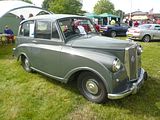

ULTIMA
VAUXHALL
Once a common sight on our roads, the Mark 1 Cavalier is not a car you see very often these days. This is from the volume selling part of the range, the 1600L. It was this car which finally provided Ford’s Cortina with some strong competition, and issue the wakeup call that something more than a reskin was going to be needed to maintain sales leadership in the 1980s. Of course, Vauxhall followed this one with a car which hit the bulls eye dead on, the first front wheel drive Cavalier in 1981, and Ford gave us the Sierra a year later. Hmm!
Family car from a much earlier era was this F series Victor. First launched in 1957, the Victor picked up the fashionable styling cues from GM’s US cars, such as the Chevrolet and Pontiac, but in a much smaller body. Sadly, they did not think about durability, and the paper thin bodies with more built in water traps than you could count had a terrible reputation for rust and most of these cars had a very short life indeed. So survivors like this Super model are rare.
The HC version of the Viva, rival to Ford’s Escort, lived for longer than the two previous cars to bear the name put together, being produced from 1970 to 1979. Despite this, few survive and so this is quite a rare car these days.
I’ve seen this Carlton before. It spent many years lingering in the darker recesses of the Atwell-Wilson Motor Museum before being purchased for not a lot of money by an enthusiast who now takes it to plenty of events during the year. Can you imagine someone buying a car in this class in orange these days? And yet, the colour suits the shape of this car quite well, I think. I understand that this is the sole surviving 1979 Carlton.
Dating from the 1930s was this 14, an upper medium sized car. These are far less well known than the competing Austin and Nuffield Group products of the era.
VOLKSWAGEN
There were a good number of classic Beetles, most of them in unmodified condition, and looking more or less like they had just emerged from the Wolfsburg (or Mexican) plant. All ages were represented from some of the early imports to the UK, along with some of the last official German built cars and a couple of the Mexican made ones from the latter part of total production.
As was the case last year, a large area had been reserved for the Corrado and Scirocco Owners Club, who then only seemed to have a couple of cars present each day. This was a nice original and unmodified car, unlike the rest of what they did bring along.
Far more to my taste was this beautifully presented Mark 1 Golf GTi.
The Golf Driver had some of the external styling cues of the GTi, but standard Golf mechanicals underneath. You don’t see them very often.
WILLYS
WOLSELEY
Selling in far larger quantities than its Riley stablemate was the Wolseley 1500, a nicely appointed mid-sized car that was a cut above the Fords, Hillman Minxes and Morris Minors of the day.
Similarly, the Hornet was the Wolseley version of the Elf, a booted and more luxurious Mini that made its debut in 1961 and ran until 1969.
Pre-dating these by a good 20 years was this rather elegant model, a six cylinder 18/85, a luxury car produced from 1938 and elsewhere in the show was a smaller four cylinder 12/48.
OLD BUSES
A fabulous array of classic buses had been secured to act as the shuttles between the venue and the city centre. I did not get the chance to ride on one of these, which may of course have changed my opinion, as these things are slow, noisy and not likely to be comfortable, but to look at, they were well worth scrutiny.
STEAM VEHICLES
One of the special attractions of the event was a collection of steam vehicles which ranged from one hundred year old Traction Engines to a marvellous Atkinson Steam Lorry. All were in steam and periodically, trundled around the grounds, at a very slow speed indeed, no faster than walking pace. Amazing to realise how fast technology advanced to obsolete these giant workhorses.
RACING LAWN MOWERS
An arena was marked out for a number of some rather special looking lawn mowers to race around. In fact, the rules are strict, and these machines are originally designed to cut grass. It was very dusty, so they got quite hard to see through what they were churning up.
NEW CARS
Inside the exhibition halls, as well as the trade stands and a craft fair, there were a small number of dealer displays, with brand new cars that you could look at, and, I guess, buy, if you really wanted to. This was a chance to have another look at some recently released models.
BMW
Positioned near the door, which meant that sunlight streamed in, making photography challenging were a number of recently launched and popular BMWs which included the latest 4 Series Convertible, the uglified X5, and the M4 and very well received 235i Coupe as well as the (also very ugly) 116i M-Sport.
DAVID BROWN
This was another chance to see the David Brown Speedback that I had previously encountered at Prescott. There was a chance to talk to the man who accompanied it., and for the first few minutes of the conversation I did wonder if t was talking to David Brown himself It turned out I was not, but clearly with a small operation, this was someone very much in the know. He said that they had been gratified by the largely positive press coverage which they had received, but even before that, several firm orders had been received. The looks have grown on me, it looking far more convincing in the metal than those initial press photos, and the interior is exquisite. Yes, it is phenomenally expensive at around £600,000, but I can see the attraction to those with deep enough pockets, as this is something rather exclusive with the reassurance of Jaguar XK mechanicals to underpin it. One clever party trick is that there is a fold down lower part of the rear hatchback and a pair of swivel up seats then emerge from the load compartment. Perfect for sitting by the race track – be that car or horse – so you have some comfort.
HONDA
I cannot warm to the Civic Tourer. Not only are its looks somewhat gawky, it also gets very pricey compared to even its far from cheap rivals. The CRV has even less appeal to me.
JAGUAR
Three Jaguars – all locked, sadly – were on show: F Type Coupe, XF Sport Brake and the luxurious XJ. All very nice indeed.
VOLKSWAGEN
VWs on show included the Lupo, Polo and soon to be replaced Passat as well as the newly launched Golf SV
COMMERCIAL VEHICLES
There were also a few commercial vehicles on show, which rather dwarfed everything else in the display hall. A reminder of just how large these vehicles are.
This was a very enjoyable event. If I am honest, there’s not really enough to keep you fully entertained for two whole days, though I was there for length of time, and did not get bored. Sunday is much busier than the Saturday, and there is far more to see, but you do need to get there early as 400 cars that you will want to see will all file out of the venue from 10:30am. There’s space for a lot more cars than the organisers manage to assemble, so it would nice to think that they can attract even more Clubs than they did in 2014 when the next event comes around. I will certainly be enrolling Abarthisti into the event, and attending it myself.

